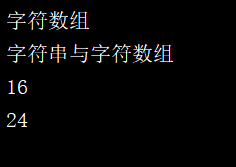通过字符数组或者字节数组创建字符串对象
String s=new String(char a[])
String s=new String(char a[],int offset,int length)
String s=new String(byte a[])
String s=new String(byte a[],int offset,int length)
package train;
public class Demo{
public static void main(String[] args) {
Demo1 s=new Demo1("hello world!");
System.out.println(s);
}
}
class Demo1
{
String str;
Demo1(String s)
{
str=s;
}
public String toString()
{
String oldMethod=super.toString();
return "调用原toString方法得出的结果:"+oldMethod+"\n调用重写的toString方法得出的结果:"+str;
}
}
运行结果如下:
总结:对象调用toString方法可以得到它的字符串表示
一般形式如下:
类名@对象的引用的字符串表示
二.
package train;
public class Demo<c> {
public static void main(String[] args) {
char[] a, b;
String s = new String("字符串与字符数组");
a = new char[4];
// public void getChars(int start,int end,char[],int offer)将当前字符串的一部分字符复制到指定的数组中
s.getChars(4, 8, a, 0);
// public char[] toCharArray()返回一个字符数组,数组长度与字符串长度相同
b = new char[8];
b = s.toCharArray();
System.out.println(a);
System.out.println(b);
// public byte[] getBytes(String charsetname)将当前字符串转换为一个字节数组,其中charsetname为字符编码方式
byte c[] = new byte[16];
byte c1[]=new byte[32];
String s1 = "字符串与字节数组";
try{c = s1.getBytes("GB2312");}//采用GB2312编码,一个汉字占2个字节
catch(Exception e){}
try{ c1=s1.getBytes("utf-8");}//采用utf-8编码,一个汉字占3个字节
catch(Exception e){}
System.out.println(c.length);
System.out.println(c1.length);
}
}
运行结果如下:


